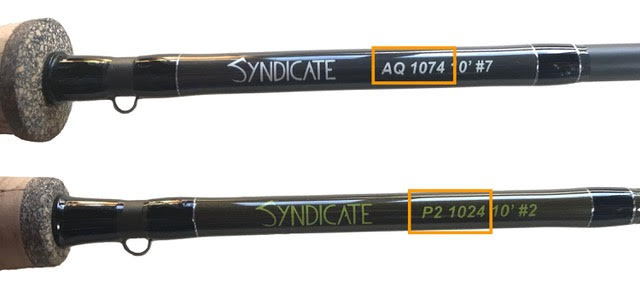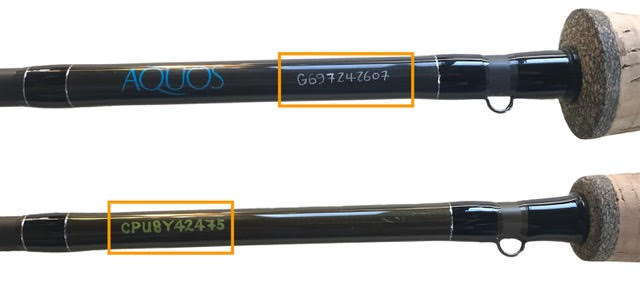Welcome to our fly fishing Frequently Asked Questions (FAQ) page. If you can't find what you're looking for, don't be shy to reach out to us through our Contact Us page. We will be sure to come back with a response as soon as we're done fishing! Otherwise, check out our fly fishing Learning Center page and Blog for more fly fishing info.
Where do I find the model number on my rod?

Where do I find the serial number on my rod?

What is European Nymphing?
European Nymphing (Euro Nymphing) is the generalization that encompasses 4 different styles of nymphing; Czech, Polish, French and Spanish. These methods incorporate 10-11 foot rods, heavy flies, in-line sighters (indicators) and usually a tight line method. Read more about European nymphing in our Learning Center.
What makes a fly rod specific to European Nymphing?
Rods that are built for European Nymphing have a strong but section and softer tip. This allows for the most sensitivity for feeling each tick of your flies on the bottom and on fish. They are also usually 10-11 feet long, some even 10-14 feet, for added reach; a necessity for keeping a tight line connection with your flies. For more info about European Nymphing fly rods, check out our European Nymphing page.
What fly rod should I buy for European Nymphing?
You should pick the rod that fits your fishing needs based on rod weight and length that you are comfortable with. Considering the average size of fish you will target, the size of the rivers you fish, and your usual style of nymphing will be helpful in this decision too. For tips in choosing the correct Euro Nymph rod, visiting our European Nymphing page or visit Choosing the Right Fly Rod.
What fly reel should I have to balance my rod?
You don't need a reel specific to European Nymphing, but it is important to pick a size to balance the rod you choose. The Pipeline series rods require a slightly heavier reel to balance correctly while the Reaver rods are capable of balancing with a lighter reel. Ideally, the rod will balance horizontally on one finger placed just in front of the cork. For a list of recommended reel weights for Syndicate fly rods, visit our Balancing Rod Specs page.
Do I need a specific line for European Nymphing?
You will benefit from using a fly line made for the European methods. While your weight forward or double taper line may suffice, it will tend to sag between guides, resulting in a loss of contact with your flies. This is due to the heavier taper of a standard line. Lines made for the European methods have little to no taper, a thin diameter and usually a braided core. A thin, minimally tapered, line is lightweight and does not sag or pull back toward the reel, allowing you to stay in contact with your flies. The braided core helps with low memory and allows the leader to be spliced into if for a seamless connection. Learn more about fly line options visit our European Nymphing page.
Why do your fly rods have up-locking reel seats rather than down locking?
This is really a story of preference, but we find that a down-locking reel seat will put the reel to far back toward the butt of the rod, making it a fulcrum that will cause excess fatigue. Also, we have found that an up-locking reel seat is stronger, making something that we can really stand behind when you put it to work.
Where are Syndicate fly rods made?
All Syndicate rods are designed in the USA and tested across the world by our trusted professionals. Each component of our rods are sourced from the highest quality manufacturers and assembled in our overseas factory in South Korea. To learn more about the Syndicate story, visit our About Us page.
Why should I choose a fly rod with a fighting butt rather than without?
This is another situation that depends mostly on personal preference, which is why we offer both options on our most popular Pipeline 10 foot 3 weight. A fighting butt can aid in balancing a rod by adding a little bit of extra weight in the butt, as well as provide something to rest against the anglers forearm while nymphing with the rod high in the air. Of course, it is always there for extra fighting ability, but some angler’s just plain don’t like it on a nymphing rod.
Why is the Reaver rod heavier than the Pipeline rod of the same size?
The Reaver series rods are built with a Pure Titanium reel seat and a 3D printed polymer handle. Both of these components are heavier than the aluminum and cork components of the Pipeline series rods, but they are also far more durable and purpose built. It is important to note that while the Reaver rod is heavier than the Pipeline, the total “outfit weight” of Reaver will be lighter because it balances with a lighter reel.
What do you mean by "outfit weight"?
